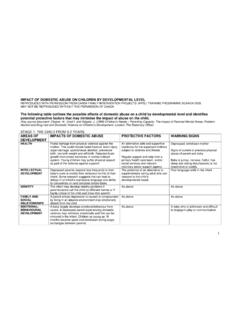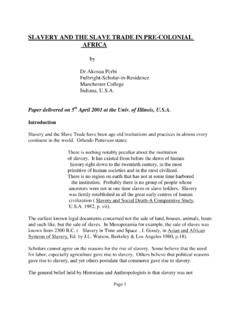Transcription of Marston Conservation Area Appraisal - Cheshire West and ...
1 Vale Royal Borough Council Marston . (LION SALT WORKS). REVISED. Conservation area . Appraisal . Conservation Areas were introduced by the Civic Amenities Act of 1967, and are now an accepted part of Town and Country Planning legislation and practice. Local Authorities are required to identify areas of special architectural or historic interest, the character of which it is desirable to preserve or enhance . They are also under a duty to review existing designations from time to time. It has been recognised that if the special interest, character and appearance of a Conservation area is to be retained, it must be managed. The first task in this process is to define and analyse the special characteristics that justify the designation of the Conservation area . This is achieved by carrying out a Conservation area Appraisal . The character of an area depends upon its historic background, the architectural quality and interest of its buildings, their materials and detailing, the way they relate to each other, the line of the highway, the quality of the landscape, trees and open spaces and a variety of unique features.
2 A Conservation area Appraisal provides a description of those elements that contribute to and define the character of the Conservation area . It also provides the basis for development plan policies and development control decisions, both within and adjacent to the Conservation area boundary. Subsequently the Appraisal will provide the background for proposals to preserve or enhance the area . It may also identify development opportunities. Therefore the Government has stated that appraisals are considered to be essential for all existing and proposed Conservation areas. Vale Royal Borough Council understands the importance of involving the local community in the Appraisal process. It has recognised that these studies are only valid if those people who are most closely affected by the designation of the Conservation area accept the content of the Appraisal . As a result, a public consultation exercise has been undertaken, the considered responses from which have been incorporated into this final version of the Appraisal .
3 The Borough Council's methodology for conducting Conservation area Appraisals has been accepted as an example of Good Practice In Conservation by the Royal Town Planning Institute. However the Council has resolved to continue to revise and improve its methodology for conducting Conservation area appraisals whilst striving to maintain a degree of consistency between the various completed studies. The principal effects of this designation are as follows: 1. The Council is under a duty to prepare proposals to ensure the preservation or enhancement of the area 2. In carrying out its functions under the Planning Acts, and in particular when determining applications for planning permission and Conservation area or listed building consent, the Council and the Secretary of State are required to take into account the desirability of preserving or enhancing the character or appearance of the area 3. Permitted development rights are more restricted within the designated area 4.
4 Consent must be obtained from the Council for the demolition of any building in the area (subject to certain exceptions). 5. Special publicity must be given to planning applications for development in the area 6. Six weeks' notice must be given to the local planning authority before any works are carried out to trees within the designated area . It becomes an offence, subject to certain exceptions, to cut down, top, lop, uproot, wilfully damage or destroy any tree in the area without the prior written consent of the local planning authority HISTORY It is useful to give a visual description of a mine at the surface, now that standing Historic evolution of the area structures no longer exist: Typically a shaft for access, winding Origins and development of the and ventilation served each mine, with settlement exposed winding gear covered by a timber roof structure. Adjacent would The Northwich area of Cheshire is well have been the horse gin circle for known for its connections with the salt winding, although steam engines were industry.
5 Increasingly used for winding rock salt The deposits of rock salt are deep below and pumping water out of the mines. the surface and therefore can only be Steam power would have been obtained by mining or brine pumping. denoted by brick engine house, boiler Romans exploited brine streams where house and chimney. they came to the surface as brine springs, Associated surface buildings would and extracted salt by evaporation. have included salt stores, crushing The first rock salt was discovered near mills, offices, stables, smithy, and Northwich in 1670, at a depth of workshop, and also accommodation for approximately 45m and was extracted mine owner or foreman. Sometimes using simple mining techniques. housing for workers was included. Many of the mines were short lived due to These often remained the only visible the ever-present threat of flooding. structures left after a mine closed. The River Weaver was made navigable in At its peak there were 29 bottom bed rock 1732, which allowed salt to be salt mines in the Northwich area , but transported out of the local area on a naturally occurring brine was also large scale for the first time, leading to an extracted throughout the period.
6 Increase in demand. As pumps increased in efficiency and The Trent and Mersey canal, which ran steam power was introduced, the rate through many of the salt working areas, of brine extraction escalated, and by was opened in 1776. the mid 19th century many of the rock Cargoes of salt were then transhipped salt mines had closed due to flooding. to boats waiting on the river Weaver at It was found that the water in the Anderton, from where they made their flooded mines dissolved the rock salt way to the port of Liverpool. and could itself be pumped out as brine Initially this was done via a series of this process of flooding and pumping basins and salt chutes' until the out the mines could also be repeated. construction of the Anderton Boat Lift The cost of making white salt from brine in 1875, which lifted the narrow canal was significantly cheaper than obtaining boats up and down the large drop that rock salt by mining.
7 Separated canal from river. Salt was manufactured using the open Later the area was served by railway. pan method, as practiced at the Lion Salt In 1779 a second lower bed of superior Works, opened in 1894 on the site of the rock salt was discovered and from then original Red Lion Inn, and run by the on all new mining operations were Thompson family. transferred to this lower level. Brine would be heated in large pans over New mines were sunk as close as a coal fire in the pan house, and once possible to the canals to facilitate bulk evaporated the salt would be dried in the transport, and in Marston the lower bed stove house. deposit was struck in 1781. Associated structures were the brine A Red Lion Inn existed in Marston in 1846 storage tank, warehouses, and a on a site just south of the canal bridge. packinghouse. 1. Intense rivalry between salt works led to Archaeological significance and the formation of the Salt Union Ltd.
8 In potential of the area 1888 to unite firms and stabilise prices. Smaller firms were squeezed out and the The salt working industry in this area of last rock salt mine closed after a major Cheshire in the 18th and 19th century was flood in 1928. on a much greater scale than anywhere Subsidence was becoming a major else in Britain, and the archaeological problem as supporting rock piers left remains are therefore of national interest during rock salt mining gradually and importance. dissolved away as a consequence brine The Lion Salt Works site is a Scheduled pumping was gradually reduced. Monument which includes: The Lion Salt Works closed in 1986 due The upstanding remains of all to the loss of its main markets in West structures associated with the Africa during the civil war in Nigeria. manufacture of salt including the It was the last working open pan salt Coronation Salt Store on the opposite works in the country.
9 Side of Ollershaw Lane. The buried remains of part of the Topographical elements that have earlier Alliance Salt Works (1856-1910). influenced the settlement form - this was also built by the Thompson's and extended to the east of the Lion The existence of valuable salt deposits Salt Works site beyond the current underground led to the origin and Scheduled Monument boundary. development of Marston . The Adelaide Salt Works was situated to Situated in a flat low-lying area , prone to the north of the canal and west of subsidence and flooding as a Ollershaw Lane, and is now partly consequence of the salt industry. covered by the flash pool. The adjacent Trent and Mersey Canal is a contour canal there are no locks locally its water surface is therefore a constant element against which the rate of subsidence in the surrounding area can be measured. Influence of current or previous land uses on the area The salt industry is responsible for the form and many of the features of the area as seen today.
10 Layout of the village core is a result of the growth of the salt industry. Mining subsidence shaped the area . st Extract from 1 Edition OS map showing Adelaide Large gaps in the streetscape where Works (1877). houses have had to be demolished. Collapse of Adelaide and Ollershaw It closed in 1928 when a shaft Works due to over mining has created collapsed and the mine flooded, and flash pools now used for fishing. was the last rock salt mine to be The Lion Salt Works remains as the most worked in mid- Cheshire . dominant collection of built structures in the area . 2. A recent archaeological survey 1. discovered structural remains, the line of an infilled canal arm, rectangular earthworks and a 2m high concrete machinery base. The Ollershaw Lane Works was situated to the north of the canal and east of Ollershaw Lane, again now partly covered by a flash pool. The raised bank to the north of the site denotes the line of the former mineral railway.






